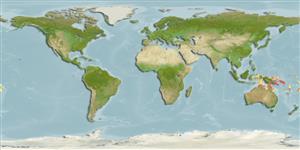Classification / Names
Common names | Synonyms | Catalog of Fishes (gen., sp.) | ITIS | CoL | WoRMS | Cloffa
Actinopterygii (ray-finned fishes) >
Perciformes (Perch-likes) >
Opistognathidae (Jawfishes)
Etymology: Opistognathus: Greek, opisthe = behind + Greek, gnathos = jaw (Ref. 45335); reticeps: Name from Latin words 'rete' for net, and 'ceps' for head, referring to the reticulated dorsum of the head, its distinguishing feature; noun in apposition.
Environment / Climate / Range
Ecology
Marine; demersal; depth range 2 - 29 m (Ref. 76827). Tropical, preferred ?
Western Pacific: Australia,
Size / Weight / Age
Maturity: Lm ? range ? - ? cm
Max length : 11.7 cm SL (female)
Short description
Morphology | Morphometrics
Dorsal
spines
(total): 12;
Dorsal
soft rays
(total): 15-16;
Anal
spines: 2;
Anal
soft rays: 13 - 14;
Vertebrae: 31. This species is distinguished by having a dorsal fin with 4 dark blotches, the first 2 extending onto distal half of fin; dorsum of head is reticulated; lateral line terminus below verticals from 10th spine to 3rd segmented dorsal-fin ray (Ref. 76827).
Benthic species which occurs inshore (Ref. 75154).
Life cycle and mating behavior
Maturity | Reproduction | Spawning | Eggs | Fecundity | Larvae
Smith-Vaniz, W.F., 2004. Descriptions of six new species of jawfishes (Opistognathidae: Opistognathus) from Australia. Rec. Aust. Mus. 56:209-224. (Ref. 76827)
IUCN Red List Status (Ref. 115185)
CITES (Ref. 94142)
Not Evaluated
Threat to humans
Harmless
Human uses
More information
Common namesSynonymsMetabolismPredatorsEcotoxicologyReproductionMaturitySpawningFecundityEggsEgg development
Age/SizeGrowthLength-weightLength-lengthLength-frequenciesMorphometricsMorphologyLarvaeLarval dynamicsRecruitmentAbundance
ReferencesAquacultureAquaculture profileStrainsGeneticsAllele frequenciesHeritabilityDiseasesProcessingMass conversion
Tools
Special reports
Download XML
Internet sources
Estimates of some properties based on models
Phylogenetic diversity index (Ref.
82805): PD
50 = 0.5000 [Uniqueness, from 0.5 = low to 2.0 = high].
Bayesian length-weight: a=0.00389 (0.00180 - 0.00842), b=3.12 (2.94 - 3.30), in cm Total Length, based on all LWR estimates for this body shape (Ref.
93245).
Trophic Level (Ref.
69278): 3.5 ±0.6 se; Based on size and trophs of closest relatives
Resilience (Ref.
69278): .
Vulnerability (Ref.
59153): Low vulnerability (10 of 100) .
